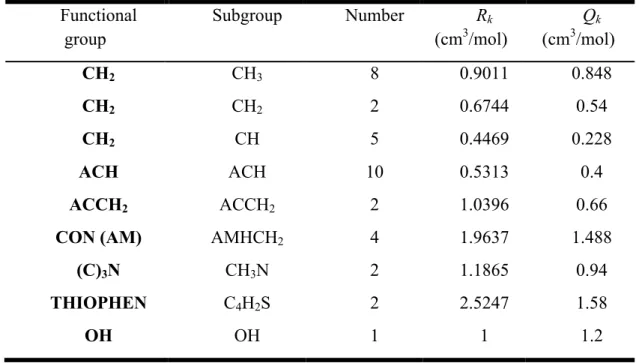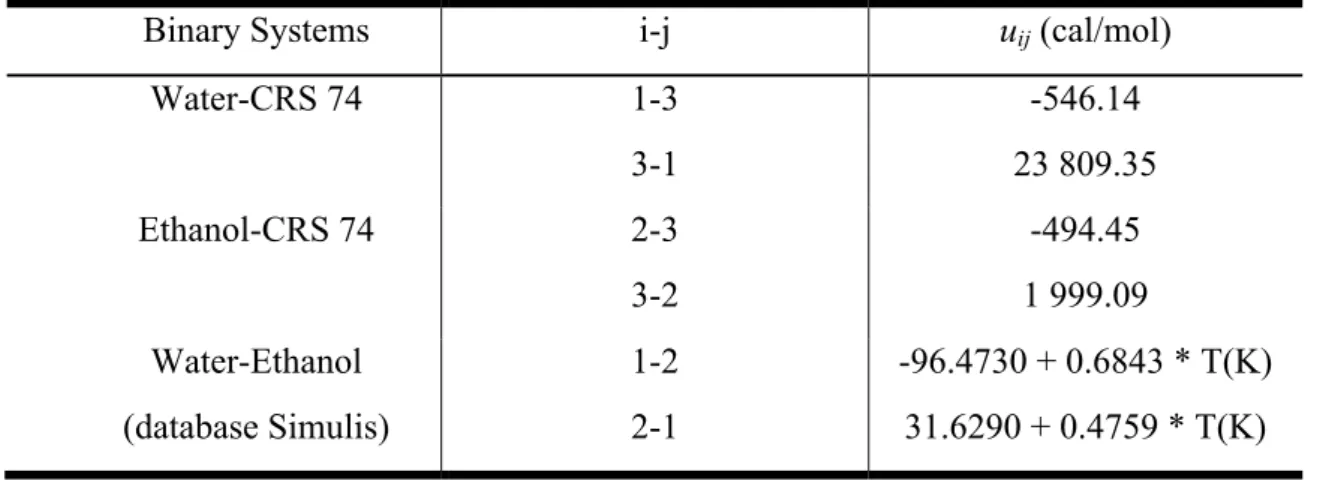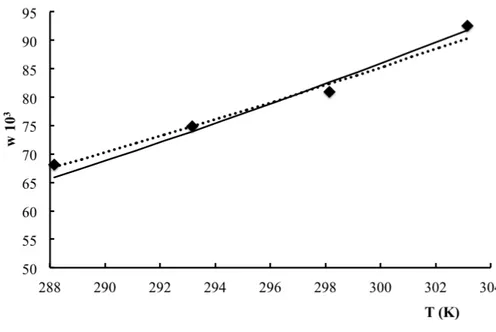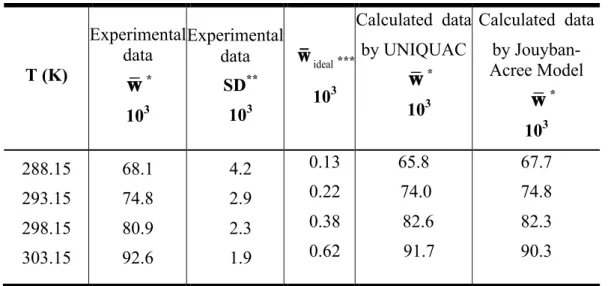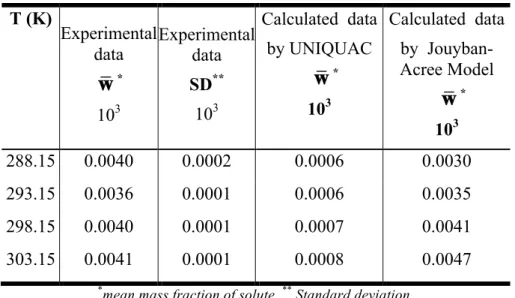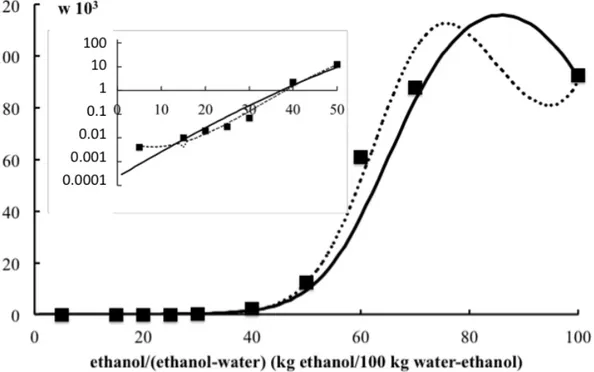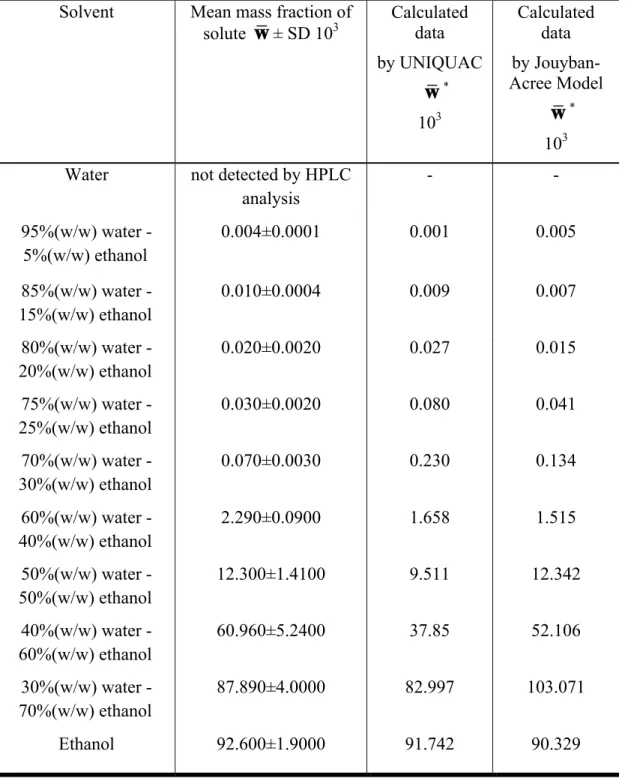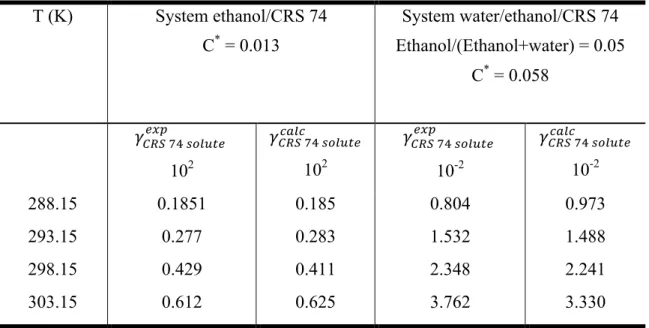HAL Id: hal-01599979
https://hal.archives-ouvertes.fr/hal-01599979
Submitted on 25 Jan 2018HAL is a multi-disciplinary open access archive for the deposit and dissemination of sci-entific research documents, whether they are pub-lished or not. The documents may come from teaching and research institutions in France or abroad, or from public or private research centers.
L’archive ouverte pluridisciplinaire HAL, est destinée au dépôt et à la diffusion de documents scientifiques de niveau recherche, publiés ou non, émanant des établissements d’enseignement et de recherche français ou étrangers, des laboratoires publics ou privés.
Solubility of a new antiretroviral drug (CRS 74) in
aqueous ethanol mixtures
Suenia de Paiva Lacerda, Jean-jacques Letourneau, Fabienne Espitalier,
Maria-Inês Ré
To cite this version:
Suenia de Paiva Lacerda, Jean-jacques Letourneau, Fabienne Espitalier, Maria-Inês Ré. Solubility of a new antiretroviral drug (CRS 74) in aqueous ethanol mixtures. Brazilian Journal of Chemical Engineering, Brazilian Society of Chemical Engineering, 2016, 33 (4), pp.1073-1081. �10.1590/0104-6632.20160334s20150340�. �hal-01599979�
SOLUBILITY OF A NEW ANTIRETROVIRAL DRUG (CRS 74) IN
AQUEOUS ETHANOL MIXTURES
S.P. LACERDA, J.J. LETOURNEAU, F. ESPITALIER *, M. I. RÉ
Université de Toulouse, Mines-Albi, UMR-CNRS 5302, Centre RAPSODEE, Campus Jarlard, F-81013 Albi CT cedex 09, France.
*Corresponding author: fabienne.espitalier@mines-albi.fr
Université de Toulouse, Mines-Albi, UMR-CNRS 5302, Centre RAPSODEE, Campus Jarlard, 81013 Albi CT cedex 09, France
Tel: (33) 5 6349 3151; Fax: (33) 5 6349 3025 BJCE-2015-0340.R1 (Editor: Pedro Pessoa) Submitted: May 28, 2015.
Revised: July 24, 2015. Accepted: July 27, 2015. Topic: Thermodynamics
Abstract - This study concerns a new antiretroviral drug named CRS 74, which has a limited bioavailability because of its low aqueous solubility and dissolution rate. To improve these properties, CRS 74 can be recrystallized by using Liquid Anti-Solvent (LAS) crystallization. Ethanol is chosen as the solvent under study for the molecule and water as the anti-solvent. Since solubility data is limited, it is necessary to collect experimental data for the molecule in relation to ethanol and water-ethanol mixtures at different temperatures in order to select suitable mixture compositions and temperature for LAS process design. In this work, the CRS 74 solubility measured in the temperature range 288.15 - 303.15 K in pure ethanol and in 95% water - 5% w/w ethanol mixtures, and the CRS 74 solubility measured at 303.15 K in water-ethanol mixtures containing from 30 to 70% w/w ethanol are presented. Measurements were performed using the shake-flask method for generating the saturated solutions followed by compositional analysis by HPLC of the solution. The experimental data showed that
the solubility of CRS 74 in binary hydroalcoholic mixtures increases upon increasing the temperature and mass fraction of ethanol.
In order to better understand the behavior of the system and to estimate supersaturation conditions for a larger range of CRS 74 crystallization conditions, two models have been chosen to describe the experimental data: UNIQUAC and Jouyban-Acree models. The modeling of experimental solid-liquid equilibrium data proved that both models could correlate satisfactorily the solubility of the studied drug. This study provided valuable data for the recrystallization of CRS 74 by using the Liquid Anti-Solvent (LAS) crystallization process.
Keywords: antiretroviral drug, solubility, UNIQUAC, aqueous ethanol mixture.
INTRODUCTION
This study concerns a new compound, (2S, 3S, 5S)-2, -5 bis- [N-[N-[[N- methyl- N-[(2-isopropyl- 4- thiazolyl) methyl] amino] carbonyl] vanilyl] amino- 1,6- diphenyl- 3- hydroxyhexane, named CRS 74. This molecule has the activity of inhibiting human immunodeficiency virus (HIV) protease, an essential enzyme involved in the HIV replication process. Consequently, this new compound can be used for the treatment of HIV infections, alone or in combination with other anti-HIV medicines.
CRS 74 has a high biological activity as disclosed in PCT document WO 2005/111006
and US 7763733 (Bockelmann et al., 2005; Bockelmann et al., 2010) but its
bioavailability is limited because of its low aqueous solubility and dissolution rate. Such properties imply difficulties not only in the design of pharmaceutical formulations, but may also result in biovariability.
Drug dissolution is a prerequisite for drug absorption and clinical response for almost all drugs administrated orally. Solid forms that have been investigated for drug
dissolution enhancement include salts, polymorphs and amorphous, among others. Amorphous formulations can achieve improved solubility, but the system is at serious
risk of crystallizing to the thermodynamically stable form, even in the solid state(Yu,
2001; Rodríguez-Spong et al., 2004). Such transformations can compromise the performance of the formulation.
To save time and resources in product development, relatively simple approaches should be tried first like crystallization. Micro/nanonization during crystallization
(Rasenack and Müller, 2002; Rasenack and Müller, 2004; Badawi et al., 2011; Viçosa et
al., 2012), surface modification (Han et al., 2011) and crystal structure modification (Eerdenbrugh et al., 2009) may improve the dissolution rate of poorly water-soluble APIs (Active Pharmaceutical Ingredients).
The Liquid Anti-Solvent (LAS) crystallization process is an attractive method for CRS74 recrystallization, aiming at controlling its dissolution kinetics. It requires mild conditions (ambient temperature and atmospheric pressure) with no requirement for expensive equipment. In the LAS process, crystallization of the solute is achieved by decreasing the solubility of the solid in the system. This is done by addition of a non-solvent component for the solute, called the anti-non-solvent and miscible with the non-solvent. The LAS crystallization process for production of ultra-fine particles has been widely
researched over the last few decades (Thorat and Dalvi, 2012). One goal in this
crystallization operation is the control of product properties, e.g., particle size and particle size distribution(Zhao et al., 2007; Zhang et al., 2009), purity, residual solvent content, crystallinity, polymorphic form (Balani et al., 2010) and dissolution rates in specific media during in vitro-tests (Viçosa et al., 2012; Plakkot et al., 2011) to a certain extent. The product properties can be manipulated by changing the process parameters and formulation.
The solvent selection is one of the essential parameters to envisage any crystallization process. Therefore, the knowledge of the solubility of a target component in different solvents is required. In this work, the solubility of CRS 74 in pure ethanol and ethanol-water binary mixtures was measured in the temperature range of 288.15 K to 303.15 K at atmospheric pressure.
Although experimental data on solubility are essential to provide information about a system and help to understand its behaviour, correlations and prediction models are also required for the correct design of crystallization processes. Solid-liquid equilibria of ternary mixtures containing ethanol (solvent), water (anti-solvent) and the new antiretroviral drug were studied and the obtained solubility data were represented using two models: the UNIQUAC-based model (Walas, 1985) and the Jouyban-Acree
model (Jouyban-Gharamaleki and Acree, 1998).
EXPERIMENTAL SECTION Materials
The molecular formula of the active pharmaceutical ingredient (CRS 74) is C46H66N8O5S2 and its molar weight 875.2 g/mol. Its chemical structure is presented in
Figure 1. It was provided with 99 % purity as a courtesy from Cristalia Ltda (Itapira, SP, Brazil). Ethanol (EtOH) (from Fluka Analytical, Sigma–Aldrich, France) and acetonitrile (ACN) high performance liquid chromatography (HPLC) grade (from Scharlau Chemie, Barcelona, Spain) were used as solvents with purity higher than 99%.
Figure 1: Chemical structure of CRS 74
S N H3C H3C N CH3 H N O CH3 H3C O N H Ph S N CH3 CH3 N CH3 N H O CH3 H3C O H N Ph OH
Methods
Solubility measurements
The solubility of CRS 74 was determined by equilibrating an excess of CRS 74 in 5 g of water, ethanol and different ethanol/water combinations at a given temperature (from 298.15 to 303.15 K) in a temperature-controlled bath for 72 hours.
According to this method, the solid drug was added in excess to a certain medium, the flasks were sealed, and shaken at a predetermined time, 24, 48 and 72 hours. The saturation was confirmed by observation of the presence of un-dissolved material and measurements of dissolved drug concentration. The concentration was determined by removing the solid phase by filtration (0.22 µm pore size, Pall 4506, France) and injection of the filtered solution onto the HPLC system with analysis at a wavelength of 210 nm. The HPLC system consisted of an Agilent Chromatograph (Model1100 series) equipped with a UV-vis detector and a HPLC column ProntoSIL 300-5-ODSH 5µm, 250x4mm ID. The flow rate of the mobile phase (acetonitrile/water in the ratio of 70:30) was 1.0 mL/min.
Differential scanning calorimetric (DSC) analysis
DSC measurement was carried out using a DSC-Q200 thermal analyzer (TA Instruments, France) in a temperature range of 293 to 483 K at a heating rate of
10° C/min under nitrogen atmosphere (50 mL min-1) in order to determine the onset of
the melting point and the fusion enthalpy with about 3 mg of solid. The molecule was characterized by a melting point of 461.75 K and a melting enthalpy of 86.6 J/g.
Modelling
Two models were chosen to describe experimental data: the UNIQUAC model
(Jouyban-Gharamaleki and Acree, 1998). The first model is based on the calculation of activity coefficients and the second is based on the mathematical representation of the solubility of drugs in mixed solvents with respect to solvent composition and temperature.
UNIQUAC model
In the UNIQUAC model, the activity coefficient is calculated by assuming a combinatorial contribution, essentially due to the differences in size and shape of the molecules, and a residual contribution essentially due to energetic interactions. The expression for the activity coefficient of the component i, 𝛾!, is described by a
combinatorial and a residual contribution:
ln 𝛾! = ln 𝛾!! + ln 𝛾
!! (1)
The combinatorial term 𝛾!! is given by:
ln 𝛾!! = ln !! !! + ! ! 𝑞! ln !! !! + 𝑙! − !! !! !𝑥! 𝑙! (2)
where 𝑥! is the mole fraction of component i; 𝑧 is the coordination number which is usually set to 10. The bulk factors 𝑙! are given by:
𝑙! = !! 𝑟!− 𝑞! − 𝑟!− 1 (3)
𝜃! and 𝜙! are the molecular surface area and molecular volume of each component i, given by: 𝜙! = !! !! !! !! ! (4) 𝜃! = !! !! !! !! ! (5)
For pure components, 𝑟! and 𝑞! are calculated as the sum of the group-volume and group-area parameters, 𝑅! and 𝑄!:
𝑟! = 𝜐!! 𝑅 !
! (6)
𝑞! = !𝜐!! 𝑄! (7)
where 𝜐!!(an integer) is the number of groups of type k in the molecule i.
The active molecule was decomposed into functional groups similarly to the group
contribution UNIFAC method. The first parameters, volume and surface parameters (𝑅!
and 𝑄!), were estimated from the volume and surface area parameters of CRS 74
functional groups. The functional groups and sub-groups are reported in Table 1. The
thiazole heterocycle (C3HNS) was replaced by the thiophene one (C4H2S). The volume
and surface area parameters ri and qi of the three components (water, ethanol and active molecule) are given in Table 2.
Table 1: UNIFAC Group Volume and Surface-Area parameters for groups of CRS 74. Functional group Subgroup Number Rk (cm3/mol) Qk (cm3/mol) CH2 CH3 8 0.9011 0.848 CH2 CH2 2 0.6744 0.54 CH2 CH 5 0.4469 0.228 ACH ACH 10 0.5313 0.4 ACCH2 ACCH2 2 1.0396 0.66
CON (AM) AMHCH2 4 1.9637 1.488
(C)3N CH3N 2 1.1865 0.94
THIOPHEN C4H2S 2 2.5247 1.58
Table 2: UNIFAC Group Volume and Surface-Area, Rk and Qk parameters for CRS 74.
Molecule i Water (DIPPR) Ethanol (DIPPR) CRS 74
ri (cm3/mol) 0.9200 2.1055 34.4615
qi (cm3/mol) 1.4000 1.9720 26.5160
The expression of the residual term is given by:
ln 𝛾!! = 𝑞
! 1 − 𝑙𝑛 !𝜃! 𝜏!" −
!! !!"
!! !!"
! (8)
In equation (8), the parameters 𝜏!" are calculated from UNIQUAC binary interaction parameters 𝑢!" as follows:
𝜏!" = 𝑒𝑥𝑝 −!!"! !!!
!" (9)
For a ternary system, twelve parameters are necessary: six parameters concerning the geometry of the molecules plus six binary interaction parameters. The binary interaction parameters (𝑢!") water/CRS 74 and ethanol/CRS 74 were identified from solubility
measurements. Binary interaction parameters water/ethanol are available in DIPPR (Data Compilation Tables of Properties of Pure Compounds) and reported in Table 3. The binary interaction parameters of the UNIQUAC model were identified in two steps. Initially, solubility data for the binary ethanol/CRS 74 as a function of temperature were considered to estimate the two binary interaction parameters ethanol/CRS 74 from the activity coefficient of the solute calculated by equation (10).
The temperature dependent experimental activity coefficient of the solute CRS 74,
𝛾!"#!" !"#$%&, can be estimated from the melting enthalpy, Δℎ!, its melting temperature Tm
and the mole fraction at saturation, 𝑥!"#!" !"#$%&, at a given solution temperature T:
ln 𝛾!"#!" !"#$%&𝑥!"#!" !"#$%& = −∆!! ! ! !− ! !! (10)
Table 3: Binary interaction parameters for the UNIQUAC model.
Binary Systems i-j uij (cal/mol)
Water-CRS 74 1-3 3-1 -546.14 23 809.35 Ethanol-CRS 74 2-3 3-2 -494.45 1 999.09 Water-Ethanol (database Simulis) 1-2 2-1 -96.4730 + 0.6843 * T(K) 31.6290 + 0.4759 * T(K)
In a second stage, the binary interaction parameters of water/CRS 74 were calculated from experimental data for the ternary water/ethanol/CRS 74 with a mass ratio ethanol/(ethanol-water) of 5 % and variable temperature. A ternary mixture was chosen because the solubility data in water as a function of temperature are not available. In both cases, the objective function C of the curve fitting method used to estimate the binary interaction parameters was the weighted root mean square error, given by:
𝐶 = ! !!"# !!"#!" !"#$%&!"#! !!!"#!" !"#$%&!"# !! ! !!"#!" !"#$%&!"#! !!!"#!" !"#$%&!"# !! ! !!"# ! (11)
in which 𝑛!"# is the number of measurements; each one corresponds to an experiment done at a temperature 𝑇!. 𝛾!"#!" !"#$%&!"#! is estimated by equation (10) and 𝛾!"#!" !"#$%&!"# 𝑇! is calculated with the UNIQUAC model in which the unknown parameters are obtained at the minimum of 𝐶.
Jouyban-Acree model
The Jouyban-Acree model is represented by Equation 12:
ln 𝑤!,!∗ = 𝑧
!ln 𝑤!,!∗ + 𝑧!ln 𝑤!,!∗ + !! !!! !!!!𝐽! 𝑧!− 𝑧! ! (12)
where 𝑤!,!∗ is the solute mass fraction solubility in the solvent mixtures at temperature T; 𝑧! and 𝑧2 are the mass fractions of solvents 1 and 2 in the absence of a solute; 𝑤1,𝑇∗
and 𝑤2,𝑇∗ denote the mass fraction solubility of the solute in the mono-solvents 1 and 2,
respectively. The terms 𝐽𝑖 are constants of the model and are computed by regressing
ln 𝑤!,!∗ − 𝑧
!ln 𝑤!,!∗ − 𝑧!ln 𝑤!,!∗ against 𝑧1 𝑧2𝑇 , 𝑧1 𝑧2𝑇 𝑧1− 𝑧2 , and 𝑧1 𝑧2𝑇 𝑧1− 𝑧2 ! using
a no-intercept least square analysis (Jouyban-Gharamaleki and Hanaee, 1997).
Combination of the Jouyban-Acree and the Van’t Hoff model enables prediction of drug solubility in mixed solvents at different temperatures after the training process by using a minimum number of solubility data points, e.g., at the lowest and highest temperatures (Jouyban et al., 2012; Sardari and Jouyban, 2013). In the training process, the model constants are computed using measured solubility data, then the solubility values at other solvent compositions and temperatures could be predicted using simple algebraic operations. The combined version could be represented as
ln 𝑤!,!∗ = 𝑧
! 𝐴!+!!! + 𝑧! 𝐴!+!!! + !! !!! !!!!𝐽! 𝑧!− 𝑧! ! (13)
RESULTS AND DISCUSSION CRS 74 solubility in pure ethanol : effect of temperature
First, the drug solubility in pure ethanol was experimentally measured within the temperature range of 288.15 to 303.15 K.
From data obtained from 24 to 72 h, it was concluded that the liquid-solid system reached equilibrium after 24 h of stirring at a controlled temperature ± 0.5 K. Thereafter
the saturation mass fraction 𝑤 was taken as the average of the three readings (Table 4
and Figure 2). The standard deviation obtained (≤ 4.2 %) is in part due to evaporation losses of solvent after sampling and, in part, closely related to systematic errors linked to analytical methods, like dilution and calibration curve.
Figure 2: Experimental (symbols) and calculated CRS 74 solubilities (solid line for the UNIQUAC model and dashed line for the Jouyban-Acree model) expressed in mass fraction in ethanol at different temperatures
Table 4: Experimental and ideal solubilities of CRS 74 expressed in mass fraction in pure ethanol as a function of temperature
T (K) Experimental data * 103 Experimental data SD** 103 *** 103 Calculated data by UNIQUAC * 103 Calculated data by Jouyban-Acree Model * 103 288.15 293.15 298.15 303.15 68.1 74.8 80.9 92.6 4.2 2.9 2.3 1.9 0.13 0.22 0.38 0.62 65.8 74.0 82.6 91.7 67.7 74.8 82.3 90.3
*meanmass fraction of solute, ** Standard deviation, *** calculated with an activity coefficient
of solute equal to 1 (equation (10).
The results revealed that this molecule exhibited a solubility in pure ethanol increasing from 68.1 ± 4.2 10-3 g/gsolution at 288.15 K to 92.6 ± 1.9 10-3 g/gsolution at 303.15 K.
CRS 74 experimental solubility in aqueous ethanol mixture containing 95% water and 5% ethanol : effect of temperature
The results revealed that this molecule exhibited a very poor solubility in pure water
(not detected by HPLC analysis). So, the drug solubility in a binary mixture containing
95 % water and 5 % ethanol was experimentally measured within the temperature range of 288.15 to 303.15 K. Table 5 and Figure 3 show the CRS 74 mass fraction as a function of temperature. It can be seen that the solubility in this mixed aqueous system was not affected by the temperature in the studied range.
w
wideal
w
Table 5: Experimental and calculated solubility of CRS 74 expressed as mass fraction in 95% (w/w) water - 5% (w/w) ethanol mixture as a function of temperature.
T (K) Experimental data * 103 Experimental data SD** 103 Calculated data by UNIQUAC * 103 Calculated data by Jouyban-Acree Model * 103 288.15 0.0040 0.0002 0.0006 0.0030 293.15 0.0036 0.0001 0.0006 0.0035 298.15 0.0040 0.0001 0.0007 0.0041 303.15 0.0041 0.0001 0.0008 0.0047
*mean mass fraction of solute, ** Standard deviation
Figure 3: Experimental (symbols) and calculated CRS 74 solubilities (solid line for
UNIQUAC model and dashed line for the Jouyban-Acree model) expressed as mass fraction in ethanol-water mixture containing 95% (w/w) water and 5% (w/w) ethanol at different temperatures
w
w
CRS 74 experimental solubility in aqueous ethanol mixture at 303.15 K: effect of the binary mixture composition
The solubility of CRS 74 in different water-ethanol mixtures at 303.15 K is listed in Table 6 and plotted in Figure 4. On the one hand, the solubility of CRS 74 increases in the aqueous ethanol mixtures with the ethanol proportion. It is well-known that the addition of an organic co-solvent to water can dramatically change the solubility of
drugs(Yalkowsky and Roseman, 1981) as observed here for more than 40 % ethanol.
On the other hand, combinations containing more than 60% water as an anti-solvent are favourable for further crystallization studies.
Figure 4: Experimental (symbols) and calculated CRS 74 solubilities (solid line for UNIQUAC model and dashed line for the Jouyban-Acree model) expressed as mass fraction in different ethanol-water mixtures at 303.15 K
Table 6: Solubility of CRS 74 expressed as mass fraction in ethanol/water mixtures at 303.15 K.
Solvent Mean mass fraction of
solute ± SD 103 Calculated data by UNIQUAC * 103 Calculated data by Jouyban-Acree Model * 103
Water not detected by HPLC
analysis - - 95%(w/w) water - 5%(w/w) ethanol 0.004±0.0001 0.001 0.005 85%(w/w) water - 15%(w/w) ethanol 0.010±0.0004 0.009 0.007 80%(w/w) water - 20%(w/w) ethanol 0.020±0.0020 0.027 0.015 75%(w/w) water - 25%(w/w) ethanol 0.030±0.0020 0.080 0.041 70%(w/w) water - 30%(w/w) ethanol 0.070±0.0030 0.230 0.134 60%(w/w) water - 40%(w/w) ethanol 2.290±0.0900 1.658 1.515 50%(w/w) water - 50%(w/w) ethanol 12.300±1.4100 9.511 12.342 40%(w/w) water - 60%(w/w) ethanol 60.960±5.2400 37.85 52.106 30%(w/w) water - 70%(w/w) ethanol 87.890±4.0000 82.997 103.071 Ethanol 92.600±1.9000 91.742 90.329
w
w
w
Correlation of solubility data by UNIQUAC and Jouyban-Acree models
UNIQUAC model. The experimental and calculated activity coefficients (𝛾!"#!" !"#$%& !"# and 𝛾!"#!" !"#$%&!"#! ) for the two systems are reported in Table 7. The root
mean square error C (see Equation (11)) for the binary system ethanol/CRS 74 and for the ternary system water/ethanol/CRS 74 are respectively 0.013 and 0.058.
Table 7: Experimental and calculated activity coefficients with UNIQUAC model for ethanol/CRS 74 and ethanol/water/CRS 74.
T (K) System ethanol/CRS 74 C* = 0.013 System water/ethanol/CRS 74 Ethanol/(Ethanol+water) = 0.05 C* = 0.058 𝛾!"# !" !"#$%& !"# 102 𝛾!"# !" !"#$%&!"#! 102 𝛾!"# !" !"#$%& !"# 10-2 𝛾!"# !" !"#$%&!"#! 10-2 288.15 293.15 298.15 303.15 0.1851 0.277 0.429 0.612 0.185 0.283 0.411 0.625 0.804 1.532 2.348 3.762 0.973 1.488 2.241 3.330 *objective function calculated with equation (11)
Jouyban-Acree model. The model parameter values were assessed by nonlinear curve fitting based on the least mean square method. The trained form of the Jouyban−Acree model for prediction of CRS 74 solubility in ethanol and water mixtures at specific temperature T is given in equation 14:
ln 𝑤!,!∗ = 𝑧
! 10.032 +!"#$.!"#! + 𝑧! 2.775 −!!"#.!"!!
+!! !!
! 3132.043 + 5395.102 𝑧!− 𝑧! − 7114.846 𝑧!− 𝑧!
where 𝑤!,!∗ denotes the solute solubility in the binary solvent mixtures at temperature T
(K) expressed in g/kg. This trained form of the model may be used to explore the predictability of the Jouyban−Acree model for the solubility of the tested drug in ethanol + water mixtures at various temperatures and solvent compositions. In addition, it may be used to predict the aqueous solubility of CRS 74 at various temperatures by considering 𝑧!=0.0 and 𝑧!=1.0.
Table 4 and Figure 2 and Table 5 and Figure 3 give respectively the solubilities calculated in pure ethanol and in 5% ethanol - 95% water mixture as a function of temperature with the two models. In pure ethanol, the calculated concentrations are in good agreement with experimental values. In 5% ethanol - 95% water mixture, the UNIQUAC model understimates the solubility of the active molecule. The Jouyban-Acree model seems to provide more accurate predictions.
Figure 4 and Table 6 present the calculated solubility at 303.15 K as a function of the ethanol mass proportion in the mixture ethanol-water with the two models. The data calculated with UNIQUAC model showed good agreement with experimental results. The two models revealed a maximum solubility of CRS 74 for an ethanol mass fraction in the mixture ethanol-water between 0.70 and 1. The maximum solubility for alcohol-water mixtures was predicted by the models but still not confirmed experimentally. A maximum solubility for a solute in a mixed solvent system has been observed experimentally for other systems (water/acetone/ketoprofen (Espitalier et al., 1995);
water/ethanol/paracetamol and water/dioxane/phenacetin (Ruckestein et al., 2003);
water/ethanol/hydrocortisone (Ali et al., 2009) and n-heptane/ethanol/eflucimide
(Teychene and Biscans, 2011)). Different studies with the Hidelbrand solubility approach have shown that the location and the height of the peaks could be linked with
amine groups of the solute give a polar character to this molecule that could explain the maximum of solubility calculated for a high ratio of ethanol in the mixture.
Indeed, the Jouyban-Acree model predicts a local minimum for the mixture 95% ethanol-5% water. To the best of our knowledge, this behaviour has not yet been described in the literature and should be treated with caution.
CONCLUSIONS
CRS 74 is soluble in ethanol (92.6 mg/gsolution at 303.15 K). To the best of our
knowledge, there are no other published data on the solubility of the new antiretroviral molecule (CRS 74) in pure ethanol and in ethanol-water mixtures.
The data generated in the present work represent a useful tool to define the mass proportion between solvent (ethanol) and anti-solvent (water) for our ongoing research on LAS recrystallization of CRS 74, in an attempt to improve its dissolution properties. The models demonstrate the capability to predict the solubility trend and magnitude, predicting a maximum in solubility in ethanol-water mixtures of around 115 mg/g solution as determined using the UNIQUAC-based model, or 112 mg/g solution using the Jouyban-Acree correlation. The data could be used for pharmaceutical purposes to explore a larger range of operating conditions for drug recrystallization, requiring less experimental measurements.
ACKNOWLEDGMENTS
The authors would like to thank Cristalia Ltda (Itapira, SP, Brazil) for providing the drug CRS 74.
REFERENCES
Ali H.S.M., York P., Blagden N., Preparation of hydrocortisone nanosuspension through a bottom-up nanoprecipitation technique using microfluidic reactors. Int. J. Pharm. 375, 107–13 (2009).
Badawi A.A., El-Nabarawi M.A., El-setouhy D.A., Alsammit S.A., Formulation and Stability Testing of Itraconazole Crystalline Nanoparticles. AAPS. 12, 3 (2011).
Balani. P.N., Wong S.Y.. W.K.Widjaja Ng. E, Tanb R.B.H., Chan S.Y., Influence of polymer content on stabilizing milled amorphous salbutamol sulphate. Int. J. Pharm. 391, 125–136 (2010).
Bockelmann M. A., Rosatto S. S., Fuzeto C. R., Vernucci, T. B., Barel D. C., Oliveira K. M. G., Freitas, M. P., Ritonavir analogous compound useful as retroviral protease inhibitor, preparation of the ritonavir analogous compound and pharmaceutical composition for the ritonavir analogous compound. European Patent, WO 2005/111006. November (2005).
Bockelmann M. A., Rosatto S. S., Fuzeto C. R., Vernucci, T. B., Barel D. C., Oliveira K. M. G., Freitas, M. P., Ritonavir analogous compound useful as retroviral protease inhibitor, preparation of the ritonavir analogous compound and pharmaceutical composition for the ritonavir analogous compound. United States patent 7763733. July (2010).
Eerdenbrugh B. V., Speybroeck M. V., Mols R., Houthoofd K., Martens J. A., Froyen
L., Humbeeck J. V., Augustijns P., Mooter G. V. D.,
Itraconazole/TPGS/Aerosil®200 solid dispersions Characterization, physical stability and in vivo performance. Eur. J. of Pharm. Sci. 38, 270–278 (2009). Espitalier F. , Biscans B. , Laguerie C., Physicochemical Data on Ketoprofen in
Solutions. J Chem. Eng. Data. 40, 1222–1224 (1995).
Han X., Ghoroi C., To D., Chen Y., Davé R., Simultaneous micronization and surface modification for improvement of flow and dissolution of drug particles. Int. J. Pharm. 415(1-2), 185-95 (2011).
Jouyban-Gharamaleki A. , Romero S. , Bustamante P. , Clark B.J., Multiple solubility maxima of oxolinic acid in mixed solvents and a new extension of Hildebrand solubility approach. Chem. Pharm. Bull. 48, 175-8 (2000).
Jouyban-Gharamaleki, A., and Acree Jr., W.E., Comparison of models for describing multiple peaks in solubility profiles. Int. J. Pharm., 167, 177-182 (1998). Jouyban-Gharamaleki, A., and Hanaee, J., A novel method for improvement of
predictability of the CNIBS/R-K equation. Int. J. Pharm., 154, 245-247 (1997). Lee P.S., Han J.Y., Song T.W., Sung J.H., Kwon O.S., Song S., Chung Y.B.,
Physicochemical characteristics and bioavailability of a novel intestinal metabolite of ginseng saponin (IH901) complexed with beta-cyclodextrin. Int. J. Pharm. 316, 29-36 (2006).
Peña M.A., Reíllo A, Escalera B., Bustamante P., Solubility parameter of drugs for predicting the solubility profile type within a wide polarity range in solvent mixtures. . Int. J. Pharm. 321, 155-61 (2006).
Plakkot S., Matas M., York P, Saunders M, Sulaiman B., Comminution of ibuprofen to produce nano-particles for rapid dissolution. Int. J. Pharm. 415, 307– 314 (2011).
Rasenack N., Müller B.W., Dissolution Rate Enhancement by in Situ Micronization of Poorly Water-Soluble Drugs. Pharm. Res. 19, 12 (2002).
Rasenack N., Müller B.W., Micron-size drug particles: common and novel micronization techniques. Pharm. Dev. Technol. 9 (1): 1-13 (2004).
Rodríguez-Spong B., Price C. P., Jayasankar A., Matzger A. J., Rodríguez-Hornedo N., General Principles of Polymorphism: A Supramolecular Perspective, Adv. Drug Deliv. Rev. 56 ,241-274 (2004).
Ruckenstein E., I. Shulgin., Solubility of drugs in aqueous solutions Part 2: Binary nonideal mixed solvent. Int. J. Pharm. 260, 283–291 (2003).
Sardari, F., and Jouyban, A., Solubility of nifedipine in ethanol + water and propylene glycol + water mixtures at (293.2 to 313.2) K. Ind. Eng. Chem. Res., 52, 14353-14358 (2013).
Smith A. J., Kavuru P., Wojtas L., Zaworotko M.J. , Shytle R.D., Cocrystals of quercetin with improved solubility and oral bioavailability. Mol. Pharm. 8, 1867-76 (2011).
Teychene S., Biscans B., A Multiscale Approach for the Characterization and Crystallization of Eflucimibe Polymorphs: from Molecules to Particles. KONA. 29, 266-282 (2011).
Thorat A. A., Dalvi, S. V., Liquid anti-solvent precipitation and stabilization of nanoparticles of poorly water soluble drugs in aqueous suspensions: Recent developments and future perspective. Chem. Eng. J. 181,1– 34 (2012).
Viçosa A., Letourneau J.-J., Espitalier F., Ré M.I., An innovative antisolvent precipitation process as a promising technique to prepare ultrafine rifampicin particles. J. Cryst. Growth. 342, 80–87 (2012).
Walas S. M., Phase equilibria in chemical engineering. Butterworth Publishers, Boston (1985).
Yalkowsky, S.H., Roseman, T.J., Solubilization of drugs by cosolvents. In: Yalkowsky (ed.) Techniques of Solubilization of Drugs, pp. 91-134. Marcel Dekker Inc., New York (1981).
Yu, L., Amorphous pharmaceutical solids: preparation, characterization and stabilization. Adv. Drug Deliv. Rev. 48, 27-42 (2001).
Zhang H., Wang J.X., Zhang Z.B., LE Y., Shen Z.G., Chen J.F., Micronization of atorvastatin calcium by antisolvent precipitation process. Int. J. Pharm. 374, 106-113 (2009).
Zhao H., Wang J.X., Wang Q.A., Chen J.F., Yun J., Controlled Liquid Antisolvent Precipitation of Hydrophobic Pharmaceutical Nanoparticles in a Microchannel Reactor. Ind. Eng. Chem. Res. 46, 8229–8235 (2007).

